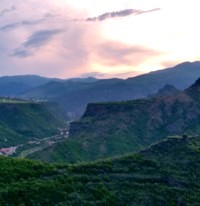Odzun and Haghpat
Not far from the Akhtala Monastery, in the Lori Province, is the village of Odzun where we stopped at an enterprising family's house for lunch. The family prepares traditional local food for coach loads of tourists and keeps bees in their garden as an attraction - to help keep the guests amused. And so we were. The family was charming; the meal was very nice; and the bees - well - they were European honey bees - just like the ones apiarists keep in Australia - except the hives were painted blue/green instead of white and seemed a little smaller. Apparently it's where honey comes from!
Here it was very evident that people have been living from hand to mouth for years, as our local guide told us: since the collapse of the Soviet Union and the dreadful mismanagement that followed.
In the village of Odzun it was very evident that people - and animals - have been 'doing it tough'
Someone was living in that house
Quite nearby, still in the in the Lori Province, is another 10th century Byzantine Monastery: the UNESCO World Heritage site of Haghpat. Wikipedia tells me that the monastery at Haghpat was chosen as an UNESCO World Heritage Site because the monastic complex:
represents the highest flowering of Armenian religious architecture, whose unique style developed from a blending of elements of Byzantine ecclesiastical architecture and the traditional vernacular architecture of the Caucasian region.'
Haghpat Monastery: 'the highest flowering of Armenian religious architecture,
whose unique style developed from a blending of elements of Byzantine ecclesiastical architecture
and the traditional vernacular architecture of the Caucasian region'
Unlike the earlier monastery it did not seem to have been fortified. I found this interesting and was motivated to look it up in Wikipedia. Read more...
It certainly enjoys a spectacular setting - countryside that was also enjoyed by our comfortably commodious hotel for the night.
The views from the balconies of our hotel suite
The meals (evening and breakfast) were also very satisfactory

